In August of 1905, United's local (and at the time more successful) rivals City were embroiled in a scandal. They were found to have been paying their players illegal payments above the £4 a week maximum wage. The FA acted by handing out a draconian punishment to the Ardwick-based side - it dismissed five of their directors and banned 17 of their players from appearing for the club again. The team that had won the FA Cup the previous year were effectively dissolved.
United were quick off the mark and with news that the players were set to be auctioned at Manchester's Queens Hotel in November, it was rumoured that they decided to make approaches to the players they wanted before the event, as they were concerned about the prices they would command at auction.
United were quick off the mark and with news that the players were set to be auctioned at Manchester's Queens Hotel in November, it was rumoured that they decided to make approaches to the players they wanted before the event, as they were concerned about the prices they would command at auction.
If the newspapers were to be believed, Mangnall privately met with a number of the City players and negotiated their transfers to United. This caused fury amongst the other interested clubs, but the FA were not interested and United secured the services of Sandy Turnbull, Jimmy Bannister and Herbert Burgess.
As well as those three, Mangnall had persuaded Billy Meredith, "The Welsh Wizard" to come to Clayton. The scorer of City's only goal in their 1904 FA Cup final victory, Meredith had been embroiled in a bribery scandal the following year and was lucky to escape a lifetime ban. Instead he was banned for a year. During this time, he was disappointed in City's unwillingness to pay him his wages and it was he who blew the whistle on their "under-the-table" dealings. Despite this he was still widely regarded as the jewel in City's crown.
These events marked the shift of power in Manchester from blue to red, and it has (barring a period between the wars) remained that way ever since. All the momentum that City had built up was transferred directly to United in one summer.
United would have to see out 1906 before they could field their new signings, and this photo shows the rest of the players at the start of the 1906-07 season in training outfits:
As well as those three, Mangnall had persuaded Billy Meredith, "The Welsh Wizard" to come to Clayton. The scorer of City's only goal in their 1904 FA Cup final victory, Meredith had been embroiled in a bribery scandal the following year and was lucky to escape a lifetime ban. Instead he was banned for a year. During this time, he was disappointed in City's unwillingness to pay him his wages and it was he who blew the whistle on their "under-the-table" dealings. Despite this he was still widely regarded as the jewel in City's crown.
These events marked the shift of power in Manchester from blue to red, and it has (barring a period between the wars) remained that way ever since. All the momentum that City had built up was transferred directly to United in one summer.
United would have to see out 1906 before they could field their new signings, and this photo shows the rest of the players at the start of the 1906-07 season in training outfits:
A photograph taken at the public practice match just before the start of the season shows the players in two different kits. Eleven of them are in the familiar home kits, while the other eleven are wearing light coloured jerseys with white collars. Not many teams wore light colours at the time. The light salmon pink shirts (as worn by the likes of Everton) had fallen out of favour several years beforehand, meaning that the choice of light colours was limited to light blue or possibly gold or yellow (although teams we traditionally associate with wearing yellow jerseys such as Norwich and Watford had not yet adopted the colour). This means it's quite possible that these shirts were in the same colour as United's rivals at Hyde Road:
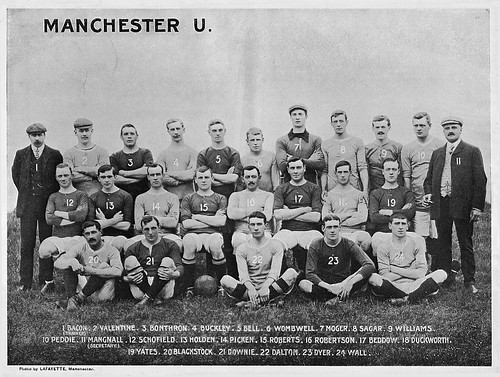
This is an edited version of an image from the extensive Leslie Millman collection, which can be found at www.flickr.com/photos/manchesterunitedman1/ and is used with full permission.
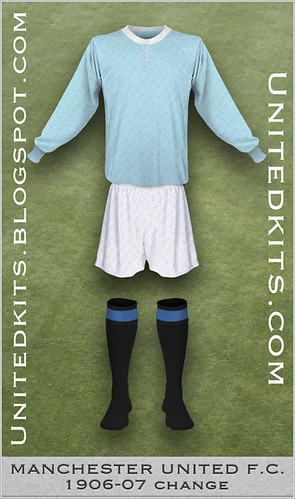

There have been a lot of anecdotal stories told by City fans over the years about how we gained our nickname (currently used exclusively by Blues) "The Rags". One of these stories involves United being so strapped for cash that they had to donate us some of their ragged old jerseys. This story certainly does not tally with the 1906 photograph as it was City who were having money problems and United who were enjoying an influx of investment.
The above photograph is also puzzling because it is the only one that features United in the light change shirts. By the first game of the 1906/07 season - a 2-1 away win at Bristol City - they were wearing new white change jerseys, which would be retained until 1909:
The above photograph is also puzzling because it is the only one that features United in the light change shirts. By the first game of the 1906/07 season - a 2-1 away win at Bristol City - they were wearing new white change jerseys, which would be retained until 1909:
Once again, with a black and white photograph as our only evidence of the kit we have to make some presumptions about colours. Although the dark collar, cuffs and socks could have been any dark colour, it is most likely they were red, in keeping with the club's traditions:
January 1st 1907 saw the long awaited debuts of the ex-City four and they were cheered onto the pitch at Bank Street by a crowd of 40,000. United beat Villa after Meredith crossed for Turnbull to score the game's only goal.
That season ended with United in a respectable 8th place, while Newcastle set a new record by winning the league with 51 points.
The downside of 1906/07 was that the Reds were knocked out of the FA Cup in a first round replay by Portsmouth. In the first game, away at Fratton Park, United again wore the new change kit, which would be used until 1909:
That season ended with United in a respectable 8th place, while Newcastle set a new record by winning the league with 51 points.
The downside of 1906/07 was that the Reds were knocked out of the FA Cup in a first round replay by Portsmouth. In the first game, away at Fratton Park, United again wore the new change kit, which would be used until 1909:
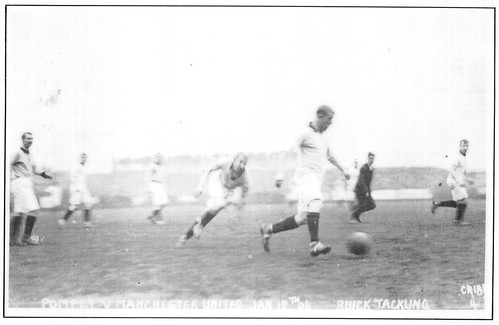
The 1907/08 United team line up for a practice match at Bank Street.:
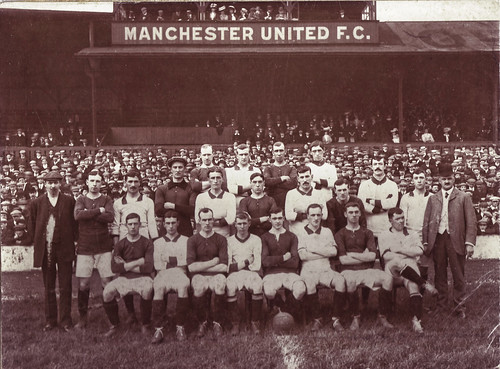
This is an edited version of an image from the extensive Leslie Millman collection, which can be found at www.flickr.com/photos/manchesterunitedman1/ and is used with full permission.
Although the kits were practically identical to those worn in previous seasons, the hooped-topped socks had been gradually replaced by plain black ones. These kits were to be worn for the next four seasons. Some players also wore socks with "cadet stripes". In fact Billy Meredith was was almost always seen in them and they seem to have appeared simultaniously with the arrival of him and his fellow ex-City players:
By May, United had beaten Newcastle's record by collecting 52 points in the First Division; The League Title had been won by a Manchester side for the first time.




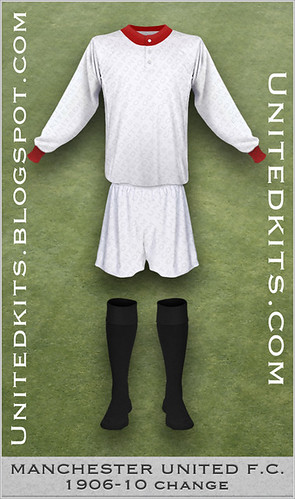
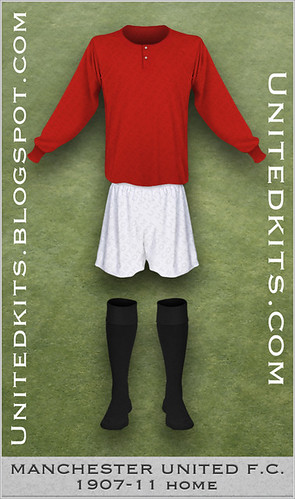

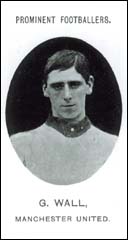

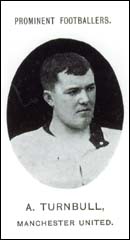
No comments:
Post a Comment